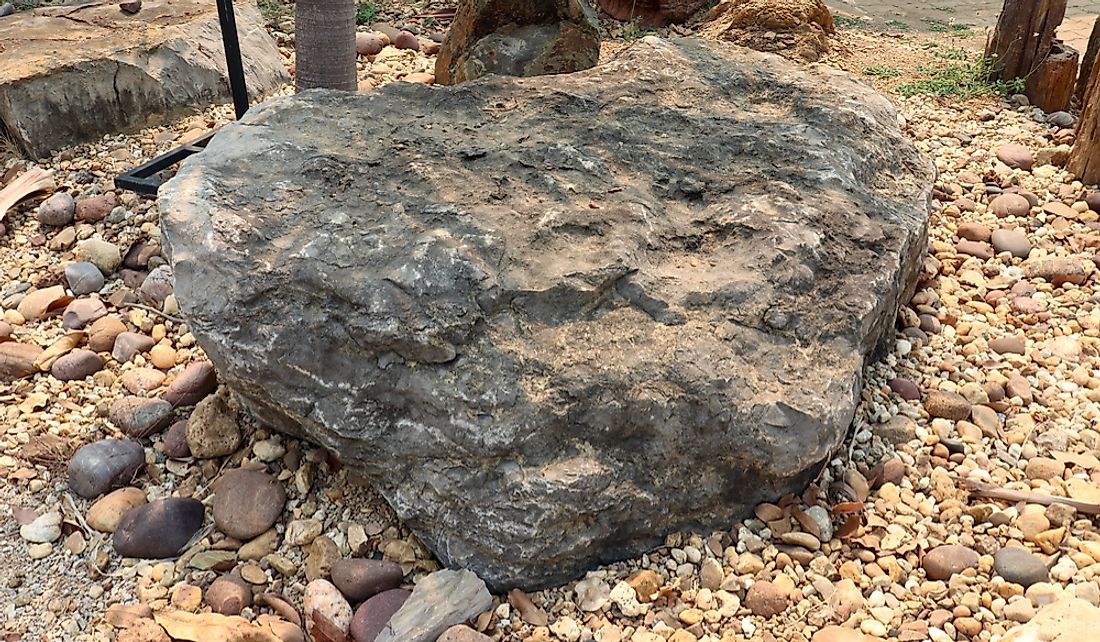What Is An Oncolite?

An oncolite is a type of sedimentary structure that is composed of oncoids formed by cyanobacterial growth. Technically, only structures that have an oncoid volume greater than 50% should be referred to as an oncolite. Structures containing oncoids that do not meet the 50% threshold are referred to as oncoidal limestone. Oncolites have a tan and roundish appearance, with an average size of less than one inch, and are typically formed by cyanobacteria through active or passive precipitation of calcium carbonate. An oncolite is formed when microbes attach to a nucleus or fossil fragment, and encrust it in layers of calcium carbonate.
Early Study of Oncoids
The term oncoid was introduced by Swiss geologist Arnold Heim in 1916. Early studies of oncoids were uncertain regarding their origin, classification, and geological significance, but various groups of oncoids based on microstructure were eventually established. Some of the groups identified include porostromate and spongiostromate oncoids, as well as skeletal and non-skeletal oncoids. However, the scientific community did not accept most of these classifications. Morphological classification by B. W. Logan (1964) is the most widely accepted modern classification.
Oncoid Occurrence
During the Phanerozoic era, oncoids were formed in various ecological environments, including brackish, marine, and freshwater environments. Apart from cyanobacteria, other organisms that have been credited with the formation of oncoids include foraminifers, microproblematica, and certain types of algae. Oncoids often do not exhibit clear lamination, such as in Bermuda and the Bahamas, as their growth is frequently destroyed. Oncoid-forming microbes are known to have high environmental tolerance, as they can survive in areas that typically have limited biodiversity, such as pools with high salinity. Marine oncoids in the Jurassic and Cambrian periods were porostromate, particularly Girvanella, while Lacustrine oncoids were mainly spongiostromate. Freshwater oncoids exhibit similarity to the ancient marine oncoids, which is the result of the replacement of porostromates in marine environments by spongiostromate.
Contribution to Scientific Studies
Based on studies in the Phanerozoic period, experts suggest that microbialites resurgence of oncoids and stromatolites could be used to signal an impending ecological crisis. The anachronistic period patterns were given acceptance by the late Ordovician mass extinction and the Frasnian-Famennian extinction. Cyanobacteria’s geological significance in relation to stromatolites is widely studied and known to play a significant role in their ecosystem. Stromatolites are used for environmental and paleo-climatological reconstruction and basin analysis.
Prehistoric Contribution of Oncoid Forming Microbes
Microbes, such as cyanobacteria, played an important role in atmospheric changes and influenced the evolution of other more complex organisms. During earlier formative periods, Earth had a primarily carbon-rich atmosphere, and oxygen levels were very limited. Scientists suggest that oxygen at that time was only produced through reactions involving sunlight and water vapor from volcanic activity. Photosynthesis, which is performed by cyanobacteria, was instrumental in increasing atmospheric oxygen levels. The gradual increase in oxygen levels created the conditions needed for the evolution of more complex organisms. Currently, cynobacteria account for about 30% of all photosynthesis on Earth and continue to play a significant role in the composition of the atmosphere.







